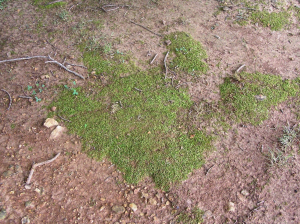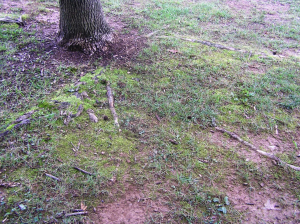Mosses, over 14,000 species of them worldwide, are major competitors with lawn grasses in certain landscape situations. They belong to their own plant family. They photosynthesize and draw moisture from tiny rhizoids (primitive root systems). They do not compete for soil nutrients with lawn grasses. Some can live in full sun, other kinds in shade areas. Mosses hug the ground, below the cutting height of lawnmowers.
Liming: Many mosses grow well in acidic soils (pH<7.0). Their presence in lawns does not mean that a lime application is necessary. A soil test can this determination. A broadcast application of granular or pelletized dolomitic or calcitic lime using a spreader is better method compared to a pulverized (powder) lime source.
Fertilization: Poor soil fertility favors the development of moss. Improve the competitive of lawn grasses by fertilizing at the proper time of year. For cool season grasses (Kentucky bluegrass, tall and fine fescues) species, spring and fall applications utilizing high nitrogen (N) fertilizer is a practical approach. For warm season (burmuda, zoysia), late spring and summer applications are best times.
Improving Soil Drainage and Aeration: Compacted soils favor growth of moss over grass, particularly in irrigated areas and excessive periods of rainfall. Core aerification of areas with wet clayey soils improves soil drainage to favor turf over moss.
Pruning: Trees compete with lawn grasses for light, water, and nutrients. Shade keeps soil moist which favors growth of moss. Selective removal of dense branching improves sunlight penetration and air circulation, which causes soil to dry out more rapidly favoring lawns over mosses.
Raking Up Fallen Tree Leaves: quick removal from the ground will dry out the soil surface quickly and improve light and air circulation.
Chemical Suppression of Mosses: the following products are sold at garden centers:
- Iron sulfate
- Ferrous ammonium sulfate
- Anti-moss products containing potassium salts
Alternative perennial ground covers including mosses instead of lawn grasses in heavily shaded areas.



 Posted in
Posted in 
